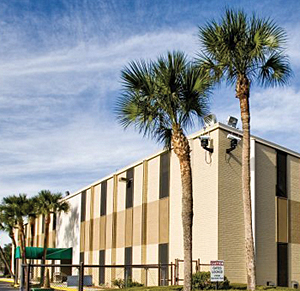Jacksonville to host second centralcast facility for public TV
The pull of economic strains and push of technical advancements continue to spark collaborations among stations, with seven pubTV outlets signing onto a CPB-backed joint master-control project in Florida and two Oregon stations preparing to link via fiber lines and share a single schedule.
The CPB Board on March 27 unanimously approved a $7 million grant for a centralcasting facility that will serve six stations in Florida and one in Georgia. The Jacksonville Digital Convergence Alliance LLC will run one master control with customized programming streams for WJCT in Jacksonville; WFSU, Tallahassee; WPBT, Miami; WBCC/WUCF, Orlando; Tampa stations WUSF and WEDU; and WPBA, Atlanta. Depending on how many additional stations sign on, the participating pubcasters will save as much as $20 million over 10 years, according to CPB’s estimates.
Cost savings have become imperative, as CPB’s supplementary appropriation for digital projects is nearly depleted. The federal aid was slashed from $36 million to $6 million in 2011, and its prospects for growing in the future are dim.
“The handwriting on the wall couldn’t be clearer,” said WJCT President Michael Boylan. Congress eliminated the Public Telecommunications Facilities Program that aided pubcasters’ technical upgrades and other equipment purchases, and CPB’s capacity to support master-control infrastructure “is all but gone,” he said. Many states that provided matching grants for broadcasting equipment have ended that support. As a system, “we need to take a look at a monumental change in thinking,” he said.
The Jacksonville initiative is similar to Centralcast LLC in Syracuse, N.Y., announced last fall and backed by $6.6 million from CPB. It will initially serve nine pubTV stations in New York and four in New Jersey (Current, Oct. 3, 2011). CPB predicts similar savings there, perhaps up to $2.5 million per year, once it launches this fall.
Meanwhile, Portland-based Oregon Public Broadcasting and Southern Oregon Public Television in Medford recently agreed to expand their programming partnership.
OPB programmers have handled scheduling for the much-smaller community licensee in the southwest corner of the state for years, with SOPTV broadcasting OPB productions such as Oregon Field Guide and Art Beat. Starting in July, SOPTV will take OPB’s entire feed, retaining the ability to insert its own interstitials, underwriting and branding. The new arrangement saves the cost of programming a separate broadcast schedule, about $10,000 annually.
Uncertainty over the future of SOPTV’s federal aid triggered the change, said Mark Stanislawski, chief executive. To reduce the station’s reliance on checks from Washington, the SOPTV board asked him to trim 10 percent of its annual CPB aid out of the 2012 budget.
For a station in a small market, SOPTV already does well in fundraising, he said, so “it’s not realistic to push that envelope even higher, especially in a recessionary environment.” The station needed “some other option, a different way to do business,” Stanislawski said.
Stations in the Jacksonville alliance are looking for new business models as well. Boylan expects that the facility could serve pubcasters far beyond the southeastern group that’s already on board. “We have been and continue to be in active discussions with stations in California, Texas, Colorado and Minnesota,” he said.
The Jacksonville joint master control will have the capacity to handle up to 34 streams from 10 to 12 stations. It will be located in the hurricane-secure facility Colo5, where the partners plan to lease space.
Establishing centralcasting facilities in Florida and New York will help keep prices low and quality high as each competes for station business, said Mark Erstling, senior v.p., system development, during the CPB Board meeting.
Geography is no longer a hurdle: Modern fiber-optics reduced the costs of linking a far-flung station to the Florida facility to about $200 more per month than a Florida station would pay. “Cost differentials have removed geography from the equation,” Erstling said. The Jacksonville project's fiber provider, TW Telecom, operates transmissions through more than 27,000 miles of fiber to almost 14,000 buildings in 75 markets.
Affordable access to fiber allowed the Oregon pubcasters to expand their partnership. OPB already leases fiber from a commercial vendor for other purposes, said Steve Bass, president. Necessary upgrades to OPB’s master control will be covered by $150,000 in bond money left from the DTV transition.
The move is “the logical next step” in the relationship between the two stations, which have worked collaboratively for years, Bass said. Three board members from each station continue to discuss additional possibilities for expanding their partnership.
The shared schedule helps ensure the best possible service to the entire state, Bass said, “and that’s part of our mission.”
There’s no signal overlap between the two: OPB covers about 85 percent of the state from Portland, in the far north; and SOPTV broadcasts in the south, from Medford to the California border. OPB is in the 22nd largest television market; SOPTV, the 140th.
OPB didn’t want to get into the multiple-station centralcast business. “The challenge with a joint master is, if you’re going to centralize all that work then somebody has to be a vendor,” Bass said. OPB didn’t see much revenue potential in taking on that role. “We’d rather focus on news and content, and not on being somebody’s technical provider,” he said.
Boylan sees opportunities to provide more than transmission services to clients by operating as a centralized repository for sharing and potentially marketing content. A documentary producer could access video from multiple stations, or a station that produces exceptional graphics or promo materials could market them to others.
“With connectivity among facilities, we can create revenue opportunities for all participating stations,” he said.
Comments, questions, tips?
Copyright 2012 American University

